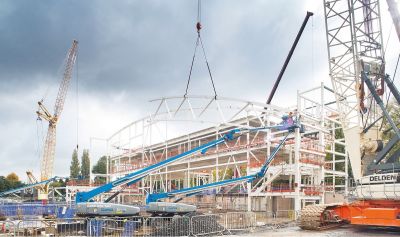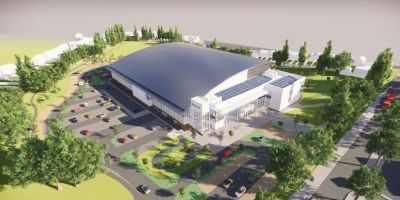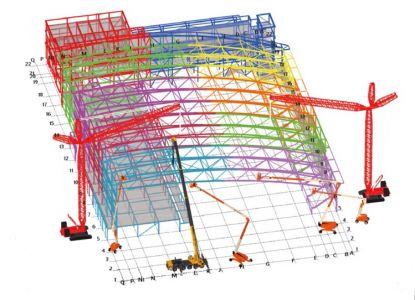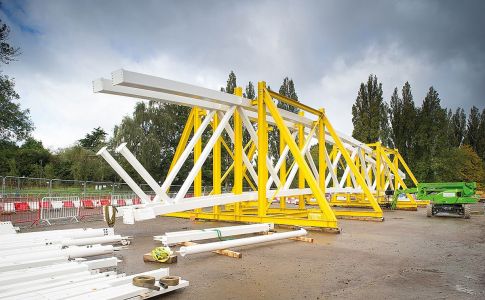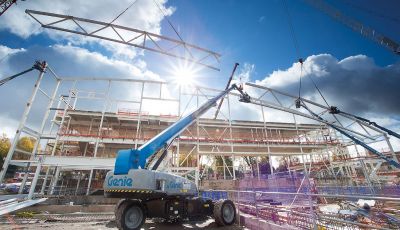Difference between revisions of "Sandwell Aquatics Centre"
| Line 22: | Line 22: | ||
The roof [[Trusses|trusses]] are curved and form a feature sloping roof. The geometry of this roof curvature has been optimised to provide [[Leisure_buildings#Sightlines and seating|sightlines]] for a 5,000-seat temporary seating terrace that is to be installed on a [[Braced_frames|steel-framed]] upper floor along the eastern side of the swimming pool (which has the 22m-high columns). “This innovative solution to accommodate the temporary seating within the envelope of the building minimised both time and cost by reducing the extent of the conversion works for legacy mode,” adds Mr Wood. | The roof [[Trusses|trusses]] are curved and form a feature sloping roof. The geometry of this roof curvature has been optimised to provide [[Leisure_buildings#Sightlines and seating|sightlines]] for a 5,000-seat temporary seating terrace that is to be installed on a [[Braced_frames|steel-framed]] upper floor along the eastern side of the swimming pool (which has the 22m-high columns). “This innovative solution to accommodate the temporary seating within the envelope of the building minimised both time and cost by reducing the extent of the conversion works for legacy mode,” adds Mr Wood. | ||
| − | <gallery mode="packed" heights= | + | <gallery mode="packed" heights=200px> |
Image:Sandwell_Aquatics_Centre-2.jpg|Two [[Construction#Mobile cranes|cranes]], positioned either side of the building, each lifted a truss half into place, while a third crane, sat within the footprint, helped with the final manoeuvring and connections | Image:Sandwell_Aquatics_Centre-2.jpg|Two [[Construction#Mobile cranes|cranes]], positioned either side of the building, each lifted a truss half into place, while a third crane, sat within the footprint, helped with the final manoeuvring and connections | ||
Image:Sandwell_Aquatics_Centre-4.jpg|Truss sections are assembled into halves before being [[Construction#Steel erection|erected]] | Image:Sandwell_Aquatics_Centre-4.jpg|Truss sections are assembled into halves before being [[Construction#Steel erection|erected]] | ||
Revision as of 16:41, 5 January 2021
Article in NSC January 2021
Flexibility spans the frame
The construction of a new state-of-the-art aquatics centre in the West Midlands has benefited from using structural steelwork in its design.
By Martin Cooper
The construction of a facility that includes a swimming pool which conforms to Olympic regulations is not an everyday occurrence. Although the UK may have plenty of 50m-long swimming pools, there are currently only 10 that meet the requirements to hold international events. That role of honour will increase when the Sandwell Aquatics Centre completes in 2022, and opens to the public the following year.
As well as an Olympic-sized 50m-long competition pool, the Centre will also include a 25m diving pool, a smaller studio pool and 1,000 permanent spectator seats along the western elevation. Alongside the swimming facilities, there will be a dry-dive facility, 108-station gym, a 25 station ladies-only gym, three activity studios, a pair of four-court sports halls, indoor cycling studio, sauna/steam room, changing rooms and a café. Externally, a new urban park will feature a children’s play area.
Being built on a former playing fields site, the Centre is founded on continuous flight auger (CFA) piled foundations with a suspended ground floor slab, due to relatively poor shallow ground conditions and high groundwater levels. With an overall footprint of 120m-long × 70m-wide, the structure is a large steel braced frame. The choice of a steel-framed solution for the project was driven by the long span roof, which for the most part is supported by no internal columns. The curved roof trusses span the width of the building accommodating both the sports hall and the pool hall.
A number of structural solutions were considered early in the design and a structural steel frame was found to be most effective. This impressive span of 70m is created by a series of 14 roof trusses, which were erected in a phased programme. According to Billington Structures, due to their size, each truss was fabricated in four pieces, which allowed them to be transported to site.
Once the truss sections were delivered to site, Billington used two laydown and assembly areas on either side of the building, where the steelwork was bolted together to form two halves of the entire roof truss. Each half was lifted into position with a tandem lift using two 250t-capacity crawler cranes that brought the two pairs together in mid-air and this is where the final connections were made. Once this final connection was completed, the entire truss was then manoeuvred to its final position, and the bolted connections to the perimeter columns were made with the aid of a 90t-capacity mobile crane positioned within the footprint of the structure.
Supporting the trusses is a series of 22m-high columns positioned along the eastern elevation and a series of 13m-high columns on the opposite façade.
As an architectural feature, much of the project’s steelwork will remain exposed within the completed project. But as a swimming pool can be a corrosive environment because of the chlorinated water, a total of eight different paint specifications, including both intumescent and corrosion protection systems, have been applied to the steelwork offsite.
“The structural design for the building has been particularly complex due to two distinct phases of construction,” explains Arup Associate Mike Wood. “The building has been designed to function as a venue for an international swimming competition without compromising the primary objective, which is to provide a legacy leisure and aquatic centre for the local community in Sandwell.”
The roof trusses are curved and form a feature sloping roof. The geometry of this roof curvature has been optimised to provide sightlines for a 5,000-seat temporary seating terrace that is to be installed on a steel-framed upper floor along the eastern side of the swimming pool (which has the 22m-high columns). “This innovative solution to accommodate the temporary seating within the envelope of the building minimised both time and cost by reducing the extent of the conversion works for legacy mode,” adds Mr Wood.
Two cranes, positioned either side of the building, each lifted a truss half into place, while a third crane, sat within the footprint, helped with the final manoeuvring and connections
Truss sections are assembled into halves before being erected
Using steelwork for the project has provided the scheme with a number benefits, alongside the ease of creating the Centre’s span and speed of construction, flexibility has also been designed into the steel frame. After the building has been used as a competition venue this area of the building, used for the temporary seating terrace, becomes the zone that accommodates the sports halls along with changing rooms and fitness studios. Additional steel-framed floors will be installed within the building envelope, with new steelwork spliced onto columns below and also located onto transfer beams. Metal deck composite floors have been detailed for these legacy floors to minimise the weight of components that need to be lifted within the building.
Summing up, Councillor Maria Crompton, Acting Leader of Sandwell Council with the responsibility for leisure says: “We are excited that the main building work on this landmark leisure centre has started. The aquatics centre will give us an international-standard venue for the local community, replacing ageing leisure facilities with a modern hub designed to promote health and wellbeing across the district.”
Sandwell Aquatics Centre is set to complete in spring 2022, with final handover to Sandwell Council in May 2023, when the building will be open to the public.
Corrosion protection in swimming pools
David Brown of the SCI discusses the importance of corrosion protection in swimming pools.
As soon as the words “swimming pool” are mentioned, all designers should think carefully about the corrosion protection required. Swimming pools are classified as corrosivity category C4 in BS EN ISO 12944-2[1], which is “high corrosivity”. The atmosphere in an indoor swimming pool is one of the most aggressive to be found in a building environment, due to the products from chlorine-based disinfectants, the higher temperature and humidity.
Stainless steel is often considered as an appropriate material in this environment, although stress corrosion cracking must be considered. The risk of stress corrosion cracking increases when susceptible grades of stainless steel are specified, in the presence of a tensile stress and a specific aggressive environment – all three conditions must occur. More information on this is provided by the HSE[2] and the British Stainless Steel Association[3].
For the Sandwell Aquatics Centre, carbon steel was used, which of course needs careful consideration of the protection system. Standard corrosion protection systems specifically for steelwork in swimming pools are available. One system is galvanized with a further paint coating system, and two systems are built up from paint alone. Including the primer and site applied finish coat, both paint systems result in a total thickness of 340 μm. This compares to a total thickness of 240 μm or 180 μm for the less aggressive C3 – medium risk environments.
The notes to the table suggest that the life of the total protection system without maintenance should exceed 25 years, though it is anticipated that for aesthetic reasons, maintenance will be carried out more frequently.
In an aggressive environment such as a swimming pool, designers should also pay attention to the corrosion of components – such as bolts – which are often visible to the pool users and should be protected properly. Some usually hidden components, such as profiled steel sheet for decking, may be equally exposed to the atmosphere and therefore need additional protection. AD 247[4] has further advice on the protection of decking, proposing additional paint protection to the steel sheet, and offering suggestions on the protection of the top surface of steel beams which – in normal construction - are left unpainted.
In summary, all aspects of material selection and corrosion protection demand special attention when the structure is an indoor swimming pool.
References
- ↑ BS EN ISO 12944-2: 2017, Paints and varnishes – Corrosion protection of steel structures by protective paint systems – Part 2: Classification of environments, BSI
- ↑ SIM 05/2002/18, Stress corrosion cracking of stainless steels in swimming pool buildings, HSE
- ↑ Stainless steels for swimming pool building applications – selection, use and avoidance of stress corrosion cracking (SCC), British Stainless Steel Association
- ↑ AD 247: Use of Composite Construction in an Aggressive Environment, SCI
| Architect | Roberts Limbrick Architects |
| Structural Engineer | Arup |
| Steelwork Contractor | Billington Structures |
| Main Contractor | Wates Construction |
| Main Client | Sandwell Metropolitan Borough Council |




